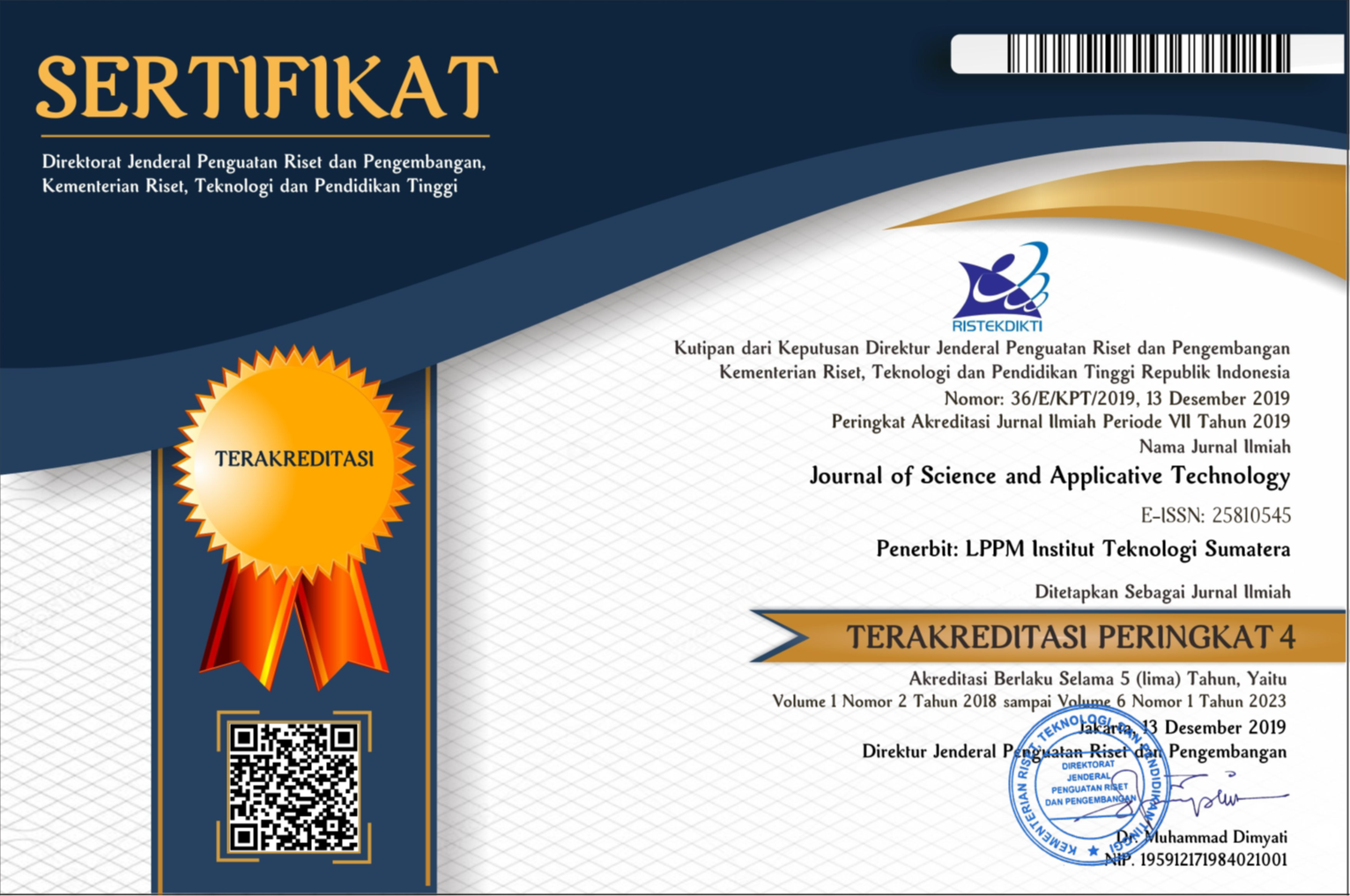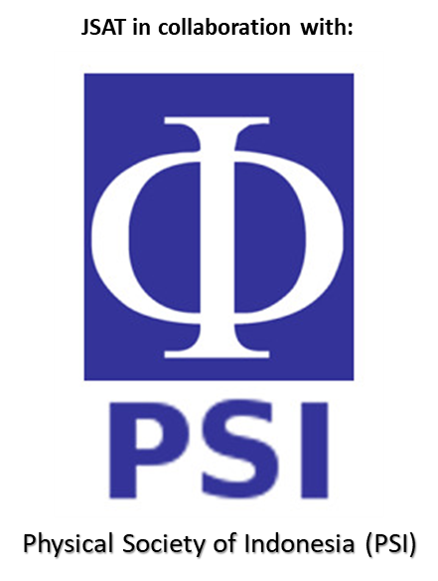Identifikasi Karakteristik Pengecilan Ukuran dengan Metode Sonikasi dari Formula Insektisida yang Ditambahkan Surfaktan Berbasis Sawit
Abstract
Size reduction of pesticide formulation can improve its performance to pest and disease control in plant. Size reduction methods were high speed agitation, ultrasonic emulsification, high pressure homogenization, microfluidic and membrane emulsification. Homogenizer and sonication methods were most widely used because its high effectivity in size reduction. The purpose of this research was to identify the effect of size reduction on physico chemical properties of the insecticide formulation by adding palm oil surfactant. The method of this research was to make an emulsifiable concentrate (EC) formulation using 15% active ingredient of emamectin benzoate, xylene, cationic surfactant of 1%, nonionic surfactants of 6% with DEA and APG surfactant ratio of 2:3. This formulation was mixed using Homogenizer at a speed of 4000 rpm and sonication with frequencies of 42 kHz at various times of 15, 30 and 45 minutes. The best result of this research was using sonication method for 45 minutes. The best physico-chemical properties were emulsion stability after 2 hours, cream formation after 24 hours emulsion, particle size of 0.70 μm with homogenous dispersion, surface tension of 25.54 dyne/cm, contact angle at 0 minutes of 25.05â° and contact angle after 15 minutes of 0â°.
Downloads
References
[2] L. Zhou,F. Luo, X. Zhang, Y. Jiang, Z. Lou, Z. Chen, "Dissipation, transfer and safety evaluation of emamectin benzoate in tea," Food Chemistry, vol. 202, pp. 199-204, 2016.
[3] C. H. Zheng, "Development of a 1.0% emamectin benzoate microemulsion," Anhui Chemical Industry, vol. 38, no. 3, pp. 49-51, 2012.
[4] D. Yang, B. Cui, C. Wang, X. Zhao, Z. Zeng, Y. Wang, C. Sun, G. Liu, H. Cui, "Preparation and characterization of emamectin benzoate solid nanodispersion," Journal of Nanomaterials, vol. 2017, pp. 1-9, 2017.
[5] E. N. Yunira, "Sintesis dan aplikasi surfaktan-surfaktan berbasis minyak sawit dalam formulasi insektisida emulsifiable concentrate (EC) dan nano emulsifiable concentrate (nano EC)," M.S Tesis, Institut Pertanian Bogor, Bogor, 2019.
[6] J. Feng, Zhang Q, Q Liu, Z Zhu, D.J. McClements, S.M. Jafari, "Application of nanoemulsions in formulation of pesticides" in Nanoemulsions: Formulation, Applications, and Characterization provides, S.M. Jafari and D.J. McClements, Ed., Cambridge : Academic Press, 2018, pp. 379-413.
[7] E.N. Yunira, A. Suryani, Dadang, "Characteristics of insecticide formulation using surfactant based on palm oil and its mortality effect against Spodoptera litura," in International Conference and the 10th Congress of the Entomological Society of Indonesia. 2019, pp. 88-93.
[8] S.B. Murdande, D.A. Shah, R.H. Dave, "Impact of nanosizing on solubility and dissolution rate of poorly soluble pharmaceuticals," Journal of Pharmaceutical Sciences, vol. 104, no. 6, p. 2094–2102, 2015.
[9] M.Y. Koroleva, E. V. Yurtov, "Nanoemulsions: the properties, methods of preparation and promising applications," Russian Chemical Reviews, vol. 81, no. 1, pp. 21-43, 2012.
[10] K Mulia, A Safiera, I. F. Pane, E. A. Krisanti, "Effect of high speed homogenizer speed on particle size of polylactic acid," In Symposium of Emerging Nuclear Technology and Engineering Novelty., Palembang, Indonesia, 4-5 Juli 2018, pp. 1-5.
[11] I. A. Rusdiana, "Peningkatan kinerja herbisida berbahan aktif isopropilamina glifosat dan surfaktan dietanolamida melalui proses sonikasi," M.S. Tesis, Institut Pertanian Bogor, Bogor, 2018.
[12] C.M. Howe , M. Berrill, B.D Pauli, C.C Helbing, K. Werry, N. Veldhoen, "Toxicity of glyphosate-based pesticides to four north american frog species," Enviromental Toxicology and Chemistry, vol. 23, no. 8, pp. 1928-1938, 2004.
[13] H. S. Dewi, M.Rahayuningsih, E. Hambali, "Formulation of insecticide profenofos using surfactant diethanolamide (DEA) based on palm olein," in International Conference on Biomass: Technology, Application, and Sustainable Development, Bogor, Indonesia, 10-11 Oktober 2016, pp. 1-12.
[14] B. Indrawijaya, "Formulasi pestisida nabati minyak mimba menggunakan surfaktan dietanolamida untuk pengendalian hama ulat grayak pada tanaman kedelai," M.S. Tesis, Institut Pertanian Bogor, Bogor, 2016.
[15] L Feng, B. Cui, D. Yang, C. Wang, Z. Zeng, Y. Wang, C. Sun, X. Zhao, H. Cui, "Preparation and evaluation of emamectin benzoate solid microemulsion," Journal of Nanomaterials, vol. 2016, pp. 1-7, 2016.
[16] T. Tadros, Encyclopedia of Colloid and Interface Science, Jerman: Springer-Verlag Berlin Heidelberg, 2013.
[17] Yusriah, E. Hambali, Dadang, "Formulasi insektisida nabati minyak bungkil mimba dengan surfaktan DEA," Jurnal Teknologi Industri Pertanian, vol. 27, no. 3, pp. 310-317, 2017.
[18] S.L. Barreiro, C. B. DÃaz, M. Costa, F. Paiva-Martins, "Distribution of catechol in emulsions," Journal of Physical Organic Chemistry, vol. 27, p. 290–296, 2013.
[19] F. Hallouard, G. Dollo, N. Brandhonneur, F. Grasset, P. L. Corre, "Preparation and characterization of spironolactone-loaded nanoemulsions for extemporaneous applications," Pharmaceutical nanotechnology, vol. 478, no. 2015, pp. 193-201, 2015.
[20] K. S. S. Putri, "Optimasi nisbah mol pati tapioka - butanol dan nisbah mol pati tapioka - fatty alcohol C10 pada proses pembuatan surfaktan nonionik alkil poliglikosida (APG)," Skripsi. Institut Pertanian Bogor, Bogor, 2010.
[21] R. Murakami, H. Moriyama, T. Noguchi, M. Yamamoto, B. P. Binks, "Effects of the density difference between water and oil on stabilization of powdered oil-in-water emulsions," Langmuir, vol. 30, no. 2, pp. 496-500, 2014.
[22] S. B Murdande, D. A. Shah, R. H. Dave, "Impact of nanosizing on solubility and dissolution rate of poorly soluble pharmaceuticals," Journal of Pharmaceutical Sciences, vol. 104, no. 6, p. 2094–2102, 2015.
[23] Cloyd RA. 2016. Effects of pH on pesticides [Internet]. [diunduh pada 2018 Nov 4] http://gpnmag.com/wp-content/uploads/2016/07/GPNJuly_Dr.Bugs_.pdf
[24] G. Yeni, S. Silfia, Y.H. Diza, “Pengaruh jenis pelarut dan kecepatan homogenizer terhadap karakteristik partikel katekin gambir,†Jurnal Litbang Industri, Vol 9, No. 1, pp. 9-14, 2019.
[25] H.W. Yarranton, H. Hussein , J.H. Masliyah, “Water-in hydrocarbon emulsions stabilized by asphaltenes at low concentrations,†Journal of Colloid and Interface Science, Vol. 228,p 52–63. 2000.
[26] M. Daaou, D. Bendedouch, “Water pH and surfactant addition effects on the stability of an algerian crude oil emulsion,†Journal of Saudi Chemical Society, Vol. 16. P 333-337, 2012.
[27] E.N. Yunira, A. Suryani, Dadang, S. Tursiloadi, “Synthesis and aplication CTAC surfactant from palmityl alcohol in insecticide emulsifiable concentrate formulation,†in 3rd International Conference on Biomass: Accelerating the Technical Development and Commercialization for Sustainable Bio-based Products and Energy, Bogor, Indonesia, 1-2 Agustus 2018, p. 1-9.

This work is licensed under a Creative Commons Attribution-NonCommercial 4.0 International License.
All the content on Journal of Science and Applicative Technology (JSAT) may be used under the terms of the Creative Commons Attribution-NonCommercial 4.0 International License.
You are free to:
- Share - copy and redistribute the material in any medium or format
- Adapt - remix, transform, and build upon the material
Under the following terms:
- Attribution - You must give appropriate credit, provide a link to the license, and indicate if changes were made. You may do so in any reasonable manner, but not in any way that suggests the licensor endorses you or your use.
- NonCommercial - You may not use the material for commercial purposes.
- No additional restrictions - You may not apply legal terms or technological measures that legally restrict others from doing anything the license permits.





















